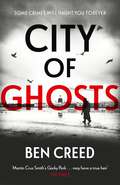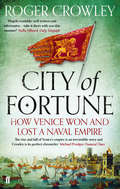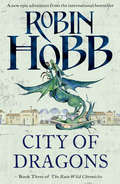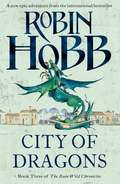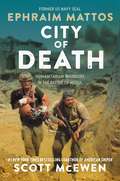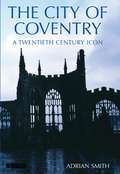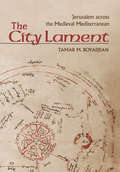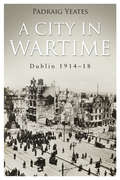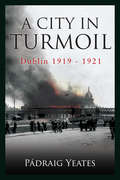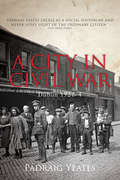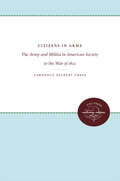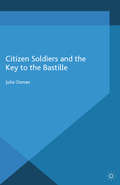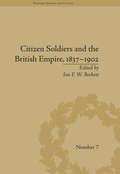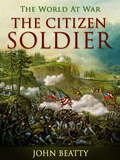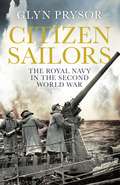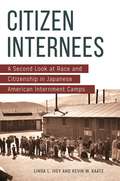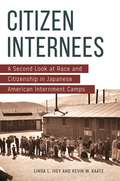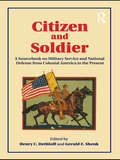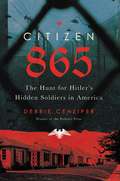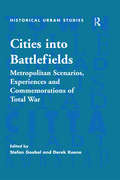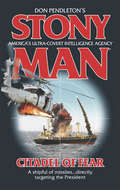- Table View
- List View
City of Ghosts: A Times 'Thriller of the Year' (A\revol Rossel Thriller Ser.)
by Ben Creed'Reminded me of Gorky Park, only I liked this tense, complex thriller even better' JAMES PATTERSON *Shortlisted for the 2021 CWA Gold Dagger and the John Creasey 'New Blood' Dagger* 'Brilliantly orchestrated and totally engrossing' THE CRIME WRITERS' ASSOCIATION ______Leningrad, Russia, 1951.The shadow of war lingers. Revol Rossel – once a virtuoso violinist with a glittering future – is now a humble state militia cop, forced to investigate desperate crimes in this desperate era.But when five frozen corpses are found neatly arranged between railway lines, Rossel is faced with the most puzzling – and most dangerous – case of his career. His hunt for the truth leads him to the dark heart of Leningrad's musical establishment, and, ultimately, to the highest levels of the Kremlin itself.It's a world he knows intimately. A world where his dreams were shattered.A world where a killer may now be hiding...'A highly assured and entertaining debut . . . Martin Cruz Smith's Gorky Park [...] may have a true heir' THE TIMES'A worthy successor to Cruz Smith's Arkady Renko . . . A fine and often moving thriller' FINANCIAL TIMES'Gripping . . . with historical heft, plenty of twists along the way, and a uniquely ingenious code left behind by our murderer. An excellent start to a new historical crime series' VASEEM KHAN
City of Fortune: How Venice Won and Lost a Naval Empire
by Roger CrowleyA magisterial work of gripping history, City of Fortune tells the story of the Venetian ascent from lagoon dwellers to the greatest power in the Mediterranean - an epic five hundred year voyage that encompassed crusade and trade, plague, sea battles and colonial adventure. In Venice, the path to empire unfolded in a series of extraordinary contests - the sacking of Constantinople in 1204, the fight to the finish with Genoa and a desperate defence against the Turks. Under the lion banner of St Mark, she created an empire of ports and naval bases which funnelled the goods of the world through its wharfs. In the process the city became the richest place on earth - a brilliant mosaic fashioned from what it bought, traded, borrowed and stole. Based on first hand accounts of trade and warfare, seafaring and piracy and the places where Venetians sailed and died, City of Fortune is narrative history at its finest. Beginning on Ascension Day in the year 1000 and ending with an explosion off the coast of Greece - and the calamitous news that the Portuguese had pioneered a sea route to India - it will fascinate anyone who loves Venice and the Mediterranean world.
City of Dragons: Dragon Keeper, Dragon Haven, City Of Dragons, And Blood Of Dragons (The Rain Wild Chronicles #3)
by Robin Hobb‘Fantasy as it ought to be written’ George R.R. Martin Return to the world of the Liveships Traders and journey along the Rain Wild River in this fantastic adventure from the author of the internationally acclaimed Farseer trilogy..
City of Dragons: Dragon Keeper, Dragon Haven, City Of Dragons, And Blood Of Dragons (The Rain Wild Chronicles #3)
by Robin Hobb'Fantasy as it ought to be written' George R.R. Martin Return to the world of the Liveships Traders and journey along the Rain Wild River in the third instalment of high adventure from the author of the internationally acclaimed Farseer trilogy.
City of Death: Humanitarian Warriors in the Battle of Mosul
by Ephraim Mattos Scott McEwenA frontline witness account of the deadly urban combat of the Battle of Mosul told by former Navy SEAL and frontline combat medic Ephraim Mattos.After leaving the US Navy SEAL teams in spring of 2017, Ephraim Mattos, age twenty-four, flew to Iraq to join a small group of volunteer humanitarians known as the Free Burma Rangers, who were working on the frontlines of the war on ISIS.Until being shot by ISIS on a suicidal rescue mission, Mattos witnessed unexplainable acts of courage and sacrifice by the Free Burma Rangers, who, while under heavy machine gun and mortar fire, assaulted across ISIS minefields, used themselves as human shields, and sprinted down ISIS-infested streets-all to retrieve wounded civilians.In City of Death: Humanitarian Warriors in the Battle of Mosul, Mattos recounts in vivid detail what he saw and felt while he and the other Free Burma Rangers evacuated the wounded, conducted rescue missions, and at times fought shoulder-to-shoulder with the Iraqi Army against ISIS. Filled with raw and emotional descriptions of what it's like to come face-to-face with death, this is the harrowing and uplifting true story of a small group of men who risked everything to save the lives of the Iraqi people and who followed the credence, "Greater love hath no man than this, that a man lay down his life for his friends."As the coauthor of the #1 New York Times bestselling American Sniper, Scott McEwen has teamed up with Mattos to help share an unforgettable tale of an American warrior turned humanitarian forced to fight his way into and out of a Hell on Earth created by ISIS.
City of Coventry: A Twentieth Century Icon
by Adrian SmithThe image of Coventry in flames was one of the most haunting of the Second World War. Yet the excitement and optimism of the 1950s and 1960s were succeeded by a quarter century of urban blight and economic slump. The collapse of manufacturing industry - machine tools, aeroplanes, cars - left a proud community adrift and demoralised. Today a revitalised twenty-first century city, Coventry has embraced the new millennium and evolved from bleak post-industrial desert to vibrant cultural oasis, in the process rediscovering a sense of purpose and a vision for the future.The City of Coventry tells the story of an experiment in social democracy carried out by a Labourcontrolled council which envisaged the bombshattered city as a model of urban regeneration and imaginative planning. Post-war reconstruction could be a striking success, as in the pedestrianfriendly Precinct and the bold new cathedral, or a notable failure as in the ever more intrusive ring roads and grim high-rise flats. In offering a fresh perspective on the city, this innovative volume of essays rediscovers Coventry as an inspiration for poets and painters such as Philip Larkin and Terry Frost, musicians as varied as Benjamin Britten and The Specials, and film-makers such as Humphrey Jennings, whose Heart of Britain was shot in the immediate aftermath of the Blitz. Adrian Smith skilfully mixes memoir, family history and meticulous scholarship to paint a complete and incisive portrait of Coventry. Drawing on new research into topics as diverse as the place of Surrealism in West Midlands culture and the shadowy presence of rugby league in a union bastion, Smith brings a unique insight into the recent history of his native city. Attractively presented, highly readable and with broad appeal, The City of Coventry is a lively re-examination of an iconic city of the twentieth century illuminating the profound changes that engulfed industrial England during and after the Second World War.
The City Lament: Jerusalem across the Medieval Mediterranean
by Tamar M. BoyadjianPoetic elegies for lost or fallen cities are seemingly as old as cities themselves. In the Judeo-Christian tradition, this genre finds its purest expression in the book of Lamentations, which mourns the destruction of Jerusalem; in Arabic, this genre is known as the ritha al-mudun. In The City Lament, Tamar M. Boyadjian traces the trajectory of the genre across the Mediterranean world during the period commonly referred to as the early Crusades (1095–1191), focusing on elegies and other expressions of loss that address the spiritual and strategic objective of those wars: Jerusalem. Through readings of city laments in English, French, Latin, Arabic, and Armenian literary traditions, Boyadjian challenges hegemonic and entrenched approaches to the study of medieval literature and the Crusades.The City Lament exposes significant literary intersections between Latin Christendom, the Islamic caliphates of the Middle East, and the Armenian kingdom of Cilicia, arguing for shared poetic and rhetorical modes. Reframing our understanding of literary sources produced across the medieval Mediterranean from an antagonistic, orientalist model to an analogous one, Boyadjian demonstrates how lamentations about the loss of Jerusalem, whether to Muslim or Christian forces, reveal fascinating parallels and rich, cross-cultural exchanges.
A City in Wartime – Dublin 1914–1918: The Easter Rising 1916 (New Perspectives On Modern Jewish History Ser. #1)
by Pádraig YeatesThis fascinating history looks at how the lives of ordinary Dubliners were affected by these three major events Why did so many working-class Dublin men join the British Army? How did the city’s 92,000 Protestants fare in this turbulent time? Dubliners fought on both sides in the Easter Rising. What were their motivations? How did Sinn Féin and the Catholic Church marginalise Labour in the battle for political control of the city after the Rising? Why did so many Dubliners benefit from the British war effort, especially tenement families and working women? Pádraig Yeates discusses each of these in detail and also looks at how the population fed itself during hard times, the impact of the war on music halls, child cruelty, prostitution, public health and much more. The Dublin as we know it was shaped in these years. And this captivating book takes you back to those times to shine a new light on the city today.
A City in Turmoil – Dublin 1919–1921: The War of Independence
by Padraig YeatesDublin was the cockpit of the Irish Revolution. It was in the capital that Dáil Éireann convened and built an alternative government to challenge the authority of Dublin Castle; it was where the munitions strike that crippled the British war effort in 1920 began and it was where rival intelligence organisations played out their deadly game of cat and mouse. But it was also a city where ambushes became a daily occurrence and ordinary civilians were caught in the deadly crossfire. Restrictions on travel, military curfews and the threat of internment would ultimately make normal life impossible.As in his previous work, A City in Wartime, Pádraig Yeates uncovers unknown and neglected aspects of the Irish Revolution, including the role that the Bank of Ireland played in keeping the city solvent, the rise of the Municipal Reform Association to challenge the hegemony of Sinn Féin and Labour, how one of Ireland's leading businessmen started out as a bagman for Michael Collins and how, ultimately, many Dubliners found it easier to sympathise with the fight for the Republic than participate in or pay for it.
A City in Civil War – Dublin 1921–1924: The Irish Civil War
by Padraig YeatesThe long-awaited concluding volume of Pádraig Yeates’ ‘Dublin at War’ trilogyIn A City in Civil War: Dublin 1921–1924, acclaimed historian Pádraig Yeates turns his attention to Ireland’s bloody and hard-fought Civil War and its impact on the capital city and its inhabitants.The fascinating A City in Civil War tells the story of Dublin’s troubled passage to independence amidst the acrimony and upheaval of the Civil War, a period in which Dublin became the capital city of an independent Irish state for the first time.Once again, conflict raged on Dublin’s streets, but this time the combatants were Irishmen – neighbours, friends, families – fighting each other. For a great many Dubliners, life remained a cycle of grinding poverty, but for many southern Unionists, ex-servicemen and anti-Treaty republicans, the city became a hostile environment. And all the while, the Catholic Church strengthened its grip on Irish cultural life, supplying many of the vital social services an embattled government was too poor and too preoccupied to provide its citizens.In his distinctive and engaging style, Pádraig Yeates uncovers unknown and neglected aspects of the Irish Civil War in the capital and their impact on the rest of the country.‘Pádraig Yeates excels as a social historian and never loses sight of the ordinary citizen.’The Irish Times ‘A powerful social history … reminds us that for all the headline grabbing events, putting bread on the table was still the most important priority for most’Professor Diarmaid Ferriter, The Irish Independent‘Reminds the reader of how daily life went on side by side with the great events of history. In short, this is an excellent addition to the current literature.’Irish Literary Supplement
Citizens in Arms: The Army and Militia in American Society to the War of 1812
by Lawrence Delbert CressThis first study to discuss the important ideological role of the military in the early political life of the nation examines the relationship between revolutionary doctrine and the practical considerations of military planning before and after the American Revolution. Americans wanted and effective army, but they realized that by its very nature the military could destroy freedom as well as preserve it. The security of the new nation was not in dispute but the nature of republicanism itself.Originally published 1982. A UNC Press Enduring Edition -- UNC Press Enduring Editions use the latest in digital technology to make available again books from our distinguished backlist that were previously out of print. These editions are published unaltered from the original, and are presented in affordable paperback formats, bringing readers both historical and cultural value.
Citizen Soldiers and the Key to the Bastille (War, Culture and Society, 1750-1850)
by Julia OsmanShowcasing French participation in the Seven Years' War and the American Revolution, this book shows the French army at the heart of revolutionary, social, and cultural change. Osman argues that efforts to transform the French army into a citizen army before 1789 prompted and helped shape the French Revolution.
Citizen Soldiers and the British Empire, 1837–1902 (Warfare, Society and Culture)
by Ian F BeckettThe British amateur military tradition of raising auxiliary forces for home defence long preceded the establishment of a standing army. This was a model that was widely emulated in British colonies. This volume of essays seeks to examine the role of citizen soldiers in Britain and its empire during the Victorian period.
Citizen Soldiers and the British Empire, 1837–1902 (Warfare, Society and Culture #7)
by Ian F BeckettThe British amateur military tradition of raising auxiliary forces for home defence long preceded the establishment of a standing army. This was a model that was widely emulated in British colonies. This volume of essays seeks to examine the role of citizen soldiers in Britain and its empire during the Victorian period.
The Citizen-Soldier: Or; Memoirs Of A Volunteer (The World At War)
by John BeattyJohn Beatty (December 16, 1828 – December 4, 1914) was an American banker and statesman from Sandusky, Ohio. He served as a brigadier general in the Union Army during the American Civil War. (Excerpt from Wikipedia)
Citizen Sailors: The Royal Navy in the Second World War
by Glyn Prysor'The deck and the bridge were pointing to the sky at an alarming angle and our thoughts were to get the devil out of it and into the water. Almost in unison we shouted "for God's sake jump boys".'Citizen Sailors is a groundbreaking people's history of the Royal Navy in the Second World War. Drawing on hundreds of contemporary diaries and letters, along with memoirs, oral history and official documents, Glyn Prysor tells the human story of Britain's war at sea.The sailors of the Royal Navy fought from the very first day of the war until the very last. They played a vital part in a truly global war, from America to Australia and from the Arctic to South Africa. They fought in every conceivable vessel: vast aircraft carriers and cramped corvettes, fast motor boats and rickety minesweepers, Swordfish biplanes and ageing submarines. Seen through the eyes of sailors themselves, this is a compelling account of life in the wartime Royal Navy: humanity and horror, triumphs and tragedies, nerve-wracking convoys and epic gun battles, devastating aerial bombardment and swashbuckling amphibious landings. Citizen Sailors puts the Royal Navy and its sailors back at the heart of the story of Britain's Second World War.
Citizen Internees: A Second Look at Race and Citizenship in Japanese American Internment Camps
by Linda L. Ivey Kevin W. KaatzThrough a new collection of primary documents about Japanese internment during World War II, this book enables a broader understanding of the injustice experienced by displaced people within the United States in the 20th century.In the 1940s, Japanese and Japanese American internees of Redwood City, CA, had a dedicated ally: J. Elmer Morrish, a banker who kept their businesses alive, made sure their taxes were paid, and safeguarded their properties until after the end of World War II and the internees were finally released. What were Morrish's motivations for his tireless efforts to help the internees? How did the unjustly incarcerated deal with the loss of freedom in the camps, and how did they envision their future? And how did the internees both cooperate with the U.S. government and attempt to resist victimization?Citizen Internees: A Second Look at Race and Citizenship in Japanese American Internment Camps is an edited selection from a collection of more than 2,000 pieces of correspondence—some of which is previously unpublished—regarding the internment of Japanese and Japanese Americans from Redwood City, CA. These primary source documents reveal the experiences and emotions of a group of imprisoned people attempting to run the necessary day-to-day tasks of the lives they were forced to leave behind—as property owners, taxpayers, and proprietors. Through these letters about practical matters, readers can gain insight into the internees' changing family relations, their financial concerns, and their struggles in making decisions about an uncertain future. The book also includes essays that supply background information, analysis of the documents' contents and meaning, and historical context.
Citizen Internees: A Second Look at Race and Citizenship in Japanese American Internment Camps
by Linda L. Ivey Kevin W. KaatzThrough a new collection of primary documents about Japanese internment during World War II, this book enables a broader understanding of the injustice experienced by displaced people within the United States in the 20th century.In the 1940s, Japanese and Japanese American internees of Redwood City, CA, had a dedicated ally: J. Elmer Morrish, a banker who kept their businesses alive, made sure their taxes were paid, and safeguarded their properties until after the end of World War II and the internees were finally released. What were Morrish's motivations for his tireless efforts to help the internees? How did the unjustly incarcerated deal with the loss of freedom in the camps, and how did they envision their future? And how did the internees both cooperate with the U.S. government and attempt to resist victimization?Citizen Internees: A Second Look at Race and Citizenship in Japanese American Internment Camps is an edited selection from a collection of more than 2,000 pieces of correspondence—some of which is previously unpublished—regarding the internment of Japanese and Japanese Americans from Redwood City, CA. These primary source documents reveal the experiences and emotions of a group of imprisoned people attempting to run the necessary day-to-day tasks of the lives they were forced to leave behind—as property owners, taxpayers, and proprietors. Through these letters about practical matters, readers can gain insight into the internees' changing family relations, their financial concerns, and their struggles in making decisions about an uncertain future. The book also includes essays that supply background information, analysis of the documents' contents and meaning, and historical context.
Citizen and Soldier: A Sourcebook on Military Service and National Defense from Colonial America to the Present
by Henry C. Dethloff Gerald E. ShenkAmericans grow up expecting that in a time of need, their country can depend on its people for volunteer service to the military. Indeed, this has been a social and at times legal expectation for the citizenship of this country since 1776. Yet, since the end of World War II United States forces have been caught up in many long term military engagements, and the military aspect of citizenship has become an increasingly marginalized one in a world where only a minority of citizens even vote. Citizen and Soldier: A Sourcebook on Military Service and National Defense from Colonial America to the Present provides a useful framework and supporting documentary evidence for an informed discussion of the development of the American ideal of the "Citizen Soldier". Presented with insightful introductions and useful discussion questions, this concise collection of 27 primary documents takes a close look at the United States military and shows how it became entwined with the rise of American national identity.
Citizen and Soldier: A Sourcebook on Military Service and National Defense from Colonial America to the Present
by Henry C. Dethloff Gerald E. ShenkAmericans grow up expecting that in a time of need, their country can depend on its people for volunteer service to the military. Indeed, this has been a social and at times legal expectation for the citizenship of this country since 1776. Yet, since the end of World War II United States forces have been caught up in many long term military engagements, and the military aspect of citizenship has become an increasingly marginalized one in a world where only a minority of citizens even vote. Citizen and Soldier: A Sourcebook on Military Service and National Defense from Colonial America to the Present provides a useful framework and supporting documentary evidence for an informed discussion of the development of the American ideal of the "Citizen Soldier". Presented with insightful introductions and useful discussion questions, this concise collection of 27 primary documents takes a close look at the United States military and shows how it became entwined with the rise of American national identity.
Citizen 865: The Hunt for Hitler's Hidden Soldiers in America
by Debbie CenziperThe gripping story of a team of Nazi hunters at the U.S. Department of Justice as they raced against time to expose members of a brutal SS killing force who disappeared in America after World War Two.In 1990, in a drafty basement archive in Prague, two American historians made a startling discovery: a Nazi roster from 1945 that no Western investigator had ever seen. The long-forgotten document, containing more than 700 names, helped unravel the details behind the most lethal killing operation in World War Two. In the tiny Polish village of Trawniki, the SS set up a school for mass murder and then recruited a roving army of foot soldiers, 5,000 men strong, to help annihilate the Jewish population of occupied Poland. After the war, some of these men vanished, making their way to the U.S. and blending into communities across America. Though they participated in some of the most unspeakable crimes of the Holocaust, "Trawniki Men" spent years hiding in plain sight, their terrible secrets intact.In a story spanning seven decades, Citizen 865 chronicles the harrowing wartime journeys of two Jewish orphans from occupied Poland who outran the men of Trawniki and settled in the United States, only to learn that some of their one-time captors had followed. A tenacious team of prosecutors and historians pursued these men and, up against the forces of time and political opposition, battled to the present day to remove them from U.S. soil. Through insider accounts and research in four countries, this urgent and powerful narrative provides a front row seat to the dramatic turn of events that allowed a small group of American Nazi hunters to hold murderous men accountable for their crimes decades after the war's end.
Citizen 865: The Hunt for Hitler's Hidden Soldiers in America
by Debbie Cenziper**Investigative Reporters and Editors (IRE) Book Award Finalist**The gripping story of a team of Nazi hunters at the U.S. Department of Justice as they raced against time to expose members of a brutal SS killing force who disappeared in America after World War Two.In 1990, in a drafty basement archive in Prague, two American historians made a startling discovery: a Nazi roster from 1945 that no Western investigator had ever seen. The long-forgotten document, containing more than 700 names, helped unravel the details behind the most lethal killing operation in World War Two. In the tiny Polish village of Trawniki, the SS set up a school for mass murder and then recruited a roving army of foot soldiers, 5,000 men strong, to help annihilate the Jewish population of occupied Poland. After the war, some of these men vanished, making their way to the U.S. and blending into communities across America. Though they participated in some of the most unspeakable crimes of the Holocaust, "Trawniki Men" spent years hiding in plain sight, their terrible secrets intact.In a story spanning seven decades, Citizen 865 chronicles the harrowing wartime journeys of two Jewish orphans from occupied Poland who outran the men of Trawniki and settled in the United States, only to learn that some of their one-time captors had followed. A tenacious team of prosecutors and historians pursued these men and, up against the forces of time and political opposition, battled to the present day to remove them from U.S. soil. Through insider accounts and research in four countries, this urgent and powerful narrative provides a front row seat to the dramatic turn of events that allowed a small group of American Nazi hunters to hold murderous men accountable for their crimes decades after the war's end.
Cities into Battlefields: Metropolitan Scenarios, Experiences and Commemorations of Total War (Historical Urban Studies Series)
by Stefan GoebelCities have always had a key role in warfare, as strategic centres which periodically suffered the horrors of siege and sack. With industrialisation, however, they were drawn ever closer to the front line and to direct and continuous experience of fighting and destruction. 'Cities into Battlefields: Metropolitan Scenarios, Experiences and Commemorations of Total War' explores the cultural imprint of military conflict on metropolises world wide in the era of the First and Second World Wars. It brings together cultural and urban historians and scholars of related disciplines including anthropology, education, and geography. The volume examines how the emergence of 'total' warfare blurred the boundaries between home and front and transformed cities into battlefields. The logic of total mobilisation turned the social and cultural fabric of urban life upside down. Arranged so as to bring out the evolution of experience over time, the essays explore Eastern and Central Europe, Britain and Western Europe, and Japan and address several key themes. The first strand - scenarios - explores the apocalyptic imagination of intellectuals and experts in peacetime. Artists and writers anticipating doom presented the coming upheaval as an urban event - a commonplace of late-Victorian and post-1918 pessimism. On a different plane, civil servants and engineers materialised visions of urban chaos and devised countermeasures in case of emergencies. Both groups helped to furnish a repertoire of cultural forms which channelled and encoded the actual experience of war. The second strand deals with metropolitan experiences, notably mobilisation, deprivation, and destruction in wartime. Ruins and the repercussions of war is the central theme of the third strand - commemorations - which investigates post-war efforts to remember and forget. The quest for meaningful forms of commemoration was hard enough after the First World War; the Second World War, which saw whole cities disappear in flames, raised the possibility that the limits of representation had been reached. The central contention of this volume - that total war in the twentieth century has a significant but often overlooked metropolitan dimension - is fully addressed, thereby filling a conspicuous gap in the currently available literature.
Cities into Battlefields: Metropolitan Scenarios, Experiences and Commemorations of Total War (Historical Urban Studies Series)
by Stefan GoebelCities have always had a key role in warfare, as strategic centres which periodically suffered the horrors of siege and sack. With industrialisation, however, they were drawn ever closer to the front line and to direct and continuous experience of fighting and destruction. 'Cities into Battlefields: Metropolitan Scenarios, Experiences and Commemorations of Total War' explores the cultural imprint of military conflict on metropolises world wide in the era of the First and Second World Wars. It brings together cultural and urban historians and scholars of related disciplines including anthropology, education, and geography. The volume examines how the emergence of 'total' warfare blurred the boundaries between home and front and transformed cities into battlefields. The logic of total mobilisation turned the social and cultural fabric of urban life upside down. Arranged so as to bring out the evolution of experience over time, the essays explore Eastern and Central Europe, Britain and Western Europe, and Japan and address several key themes. The first strand - scenarios - explores the apocalyptic imagination of intellectuals and experts in peacetime. Artists and writers anticipating doom presented the coming upheaval as an urban event - a commonplace of late-Victorian and post-1918 pessimism. On a different plane, civil servants and engineers materialised visions of urban chaos and devised countermeasures in case of emergencies. Both groups helped to furnish a repertoire of cultural forms which channelled and encoded the actual experience of war. The second strand deals with metropolitan experiences, notably mobilisation, deprivation, and destruction in wartime. Ruins and the repercussions of war is the central theme of the third strand - commemorations - which investigates post-war efforts to remember and forget. The quest for meaningful forms of commemoration was hard enough after the First World War; the Second World War, which saw whole cities disappear in flames, raised the possibility that the limits of representation had been reached. The central contention of this volume - that total war in the twentieth century has a significant but often overlooked metropolitan dimension - is fully addressed, thereby filling a conspicuous gap in the currently available literature.
Citadel Of Fear
by Don PendletonSTONY MAN America's elite black ops team Stony Man Farm is dedicated to protecting the innocent. Acting on orders of the President, these soldiers and cyber techs are the nation's best defense against violence and terror across the globe.
